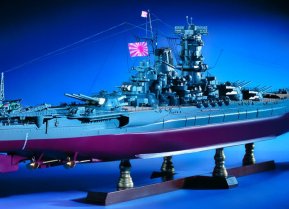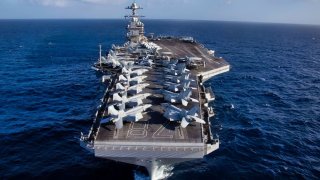Did Star Wars Prove the Age of the Battleship and Aircraft Carrier Is Over?
The opening scenes of "Star Wars: The Last Jedi" mirror the historical interwar debates on the effectiveness of air power against naval forces, specifically focusing on the dynamics between aircraft and capital ships, like battleships and other large warships.
Summary: The opening scenes of "Star Wars: The Last Jedi" mirror the historical interwar debates on the effectiveness of air power against naval forces, specifically focusing on the dynamics between aircraft and capital ships, like battleships and other large warships. The film showcases a Resistance attack on a First Order dreadnought using X-Wing fighters to disable defenses, followed by a bombing run that, despite heavy losses, results in the destruction of the dreadnought. This scenario echoes the arguments led by General Billy Mitchell in the 1920s about the power of bombers over naval ships. Critics of Mitchell pointed out flaws in his demonstrations, such as the target ship's inability to maneuver or defend itself, highlighting the complexity of applying air power against naval targets. These debates extended to the types of aircraft best suited for such missions, contrasting heavy bombers with naval aviators' preference for dive and torpedo bombers. World War II largely validated the naval approach, with carrier-based aircraft proving crucial in maritime engagements. "The Last Jedi" leans towards Mitchell's perspective, emphasizing the potential of bombers despite their vulnerability. However, the film and historical realities diverge, with modern advancements blurring the lines between fighters and bombers and changing the role of surface ships in warfare.
Bombers vs. Battleships: Echoes of History in The Last Jedi
The first twenty minutes of Star Wars: The Last Jedi might have warmed the heart of Billy Mitchell’s Force ghost. The opening scenes effectively replayed the American interwar debates between advocates of air and naval power, with fighters and bombers attacking huge capital ships. These debates revolved around two big questions that drove procurement and the development of doctrine: how effective are aircraft against capital ships like battleships, and what kind of aircraft are most effective?
The Scene
The opening moments of The Last Jedi depict a capital-ship-led attack against a Resistance base. Resistance X-Wing fighters manage to destroy the point defenses of the largest First Order capital ship, a Mandator-class dreadnought, enabling a force of B/SF-17 bombers to attack the dreadnought with gravity bombs. Although First Order interceptors manage to destroyer most of the bomber force, one ship gets through, delivering an attack that destroys the warship. The overall impact of the strike is mixed: the First Order loses one of its more powerful ships, but it apparently has other warships on hand. The Resistance loses its bomber fleet, which is the only weapon it has to deter First Order capital ships. On balance, the leaders of the Resistance seem to feel that losing the bomber fleet wasn’t worth it.
The scene stands in some contrast to the last act of Star Wars: Episode IV—A New Hope, where a group of X-Wing fighters and Y-Wing fighter-bombers manage to deliver a precision attack that destroys the Imperial Death Star. Indeed, the fighters in the Battle of Yavin demonstrate greater survivability than the fighter-bombers. Nevertheless, the lessons seem reasonably clear; small craft can destroy capital ships if used in appropriate numbers and at appropriate times.
The Debate
During the interwar period, advocates of air and sea power endlessly debated the effectiveness of air attacks against capital ships such as battleships. The U.S. Army’s Gen. William “Billy” Mitchell helped kick off the debate by orchestrating a demonstration of the decisive effect of air power in July 1921. U.S. Army Air Service level bombers repeatedly attacked the former German battleship Ostfriesland, recently acquired as war reparations, until the ship sank. Mitchell counted the demonstration as vindication for the power of bombers; critics noted that Ostfriesland was in extremely poor condition, that it had no crew for damage control, that it could not maneuver, and that it had no antiaircraft weapons to deter the attacks.
Nevertheless, Mitchell argued emphatically that the advent of bombers had made most surface ships, including aircraft carriers, obsolete.
Another debate involved the type of aircraft necessary to defeat ships. Aviators in the U.S. Army, including Mitchell and his acolytes, generally argued that the missions of bombing cities and bombing battleship required essentially the same type of aircraft; heavy bombers capable of delivering precision, high-altitude attacks at long range from their bases. Indeed, the initial tenders for the legendary B-17 Flying Fortress emphasized coastal-defense capability. American naval aviators, by contrast, argued in favor of dive and torpedo bombers: fighter-sized planes that could launch from aircraft carriers, then avoid enemy defenses to deliver attacks against critical points on enemy vessels. These debates inevitably bled into other important debates, most notably the importance of having an independent air force, and the relative value of aircraft carriers and battleships.
The experience of the war emphatically vindicated the Navy’s approach. U.S. naval aviation devastated Japanese shipping, destroying numerous capital ships through torpedo and dive-bombing attacks, while Army Air Force heavy bombers inflicted very little damage in direct attacks against enemy surface ships. Army bombers made their primary contribution through the dropping of mines (which disrupted Axis coastal shipping) and through antisubmarine duties, both of which proved exceptionally effective, but were not generally expected to be decisive in prewar airpower thinking.
Who Wins?
The Last Jedi seems to settle on Billy Mitchell’s side; the bomber gets through and destroys the Dreadnought, even if the cost of victory is dear. To be fair, the Star Wars universe is not entirely consistent or coherent regarding the relationship between small fighter and bomber craft and the capital ships that can launch them, making it difficult to assess the balance between light and heavy fighter-bombers.
In the real world, technological progress has made many of these arguments irrelevant. The gap between fighters and bombers has closed, and both can deliver the ordnance necessary to destroy surface ships. Surface vessels themselves, with the possible exception of aircraft carriers, are no longer expected to absorb significant battle damage. And carrier aircraft now pack much the same punch as their land-based brethren.
But as George Lucas himself has acknowledged, Star Wars has its heart in World War II (Lucas once suggested that Red Tails, a chronicle of the exploits of the Tuskegee airmen, was the true sequel to Return of the Jedi). It is not surprising that the debates that animated military thinking in World War II, from bombers to fighters to battleships, should also appear in the military milieu that Star Wars is built upon.
About the Author: Dr. Robert Farley
Robert Farley, a frequent contributor to TNI, is author of The Battleship Book. He serves as a Senior Lecturer at the Patterson School of Diplomacy and International Commerce at the University of Kentucky. His work includes military doctrine, national security, and maritime affairs. He blogs at Lawyers, Guns and Money and Information Dissemination and The Diplomat.


